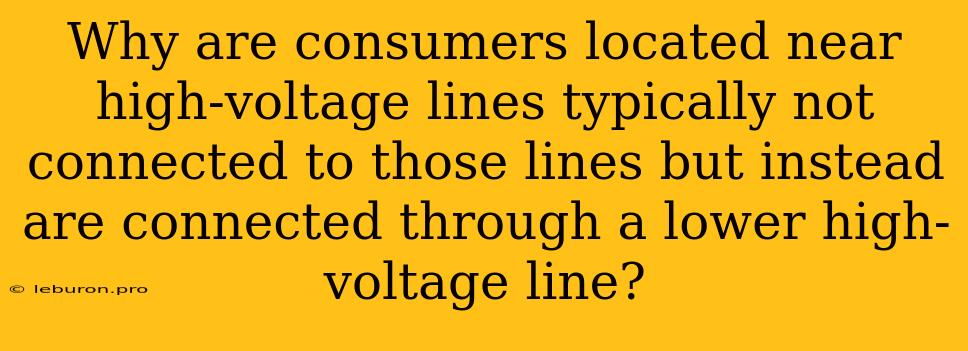The distribution of electricity from power plants to consumers is a complex process that involves multiple stages of voltage transformation. While high-voltage lines carry electricity efficiently over long distances, they are not directly connected to homes and businesses. Instead, consumers are typically connected to lower-voltage lines, even if they live near high-voltage lines. This strategic design is rooted in safety considerations and the need for efficient voltage management.
Understanding the Voltage Transformation Process
Electricity generated at power plants is typically at high voltages, ranging from hundreds of thousands to millions of volts. This high voltage is necessary for efficient transmission over long distances, minimizing energy loss. However, high-voltage electricity is not safe for direct use in homes and businesses. Therefore, the voltage must be reduced before it reaches consumers.
The process of reducing voltage is called voltage transformation, and it's accomplished using specialized equipment called transformers. Here's how it works:
- Step-up Transformers: At the power plant, step-up transformers increase the voltage to high levels for efficient transmission.
- High-Voltage Transmission Lines: These high-voltage lines, often referred to as transmission lines, carry the electricity over long distances to distribution substations.
- Step-down Transformers: At distribution substations, step-down transformers reduce the voltage to a lower level, typically in the range of 12,000 to 34,500 volts.
- Distribution Lines: These lower-voltage lines carry the electricity to neighborhoods and businesses.
- Step-down Transformers: Finally, smaller transformers located near individual homes and businesses further reduce the voltage to 120/240 volts, which is safe for residential and commercial use.
Why Not Connect Consumers Directly to High-Voltage Lines?
Connecting consumers directly to high-voltage lines would pose significant safety risks. Here are the key reasons:
- High Voltage is Extremely Dangerous: High-voltage electricity can be fatal, even with brief contact. Connecting homes and businesses to high-voltage lines would increase the risk of electric shock, fires, and other hazards.
- Voltage Fluctuations: High-voltage lines are susceptible to voltage fluctuations caused by changes in demand or system faults. These fluctuations can damage appliances and electronic equipment.
- Electromagnetic Interference: High-voltage lines generate powerful electromagnetic fields that can interfere with electronic devices, communication systems, and even medical equipment.
The Role of Lower-Voltage Lines
Lower-voltage lines serve as a crucial buffer between high-voltage transmission lines and consumers. They provide several advantages:
- Safer for Consumers: The lower voltage reduces the risk of electric shock and other hazards, making it safe for everyday use.
- Voltage Stability: Lower-voltage lines experience less voltage fluctuation, ensuring stable power supply to consumers.
- Reduced Electromagnetic Interference: Lower-voltage lines generate weaker electromagnetic fields, minimizing interference with electronic devices.
- Efficient Distribution: Lower-voltage lines are more efficient in distributing electricity to individual homes and businesses within local areas.
Why are Consumers Located Near High-Voltage Lines Typically Not Connected to Those Lines but Instead Are Connected Through a Lower High-Voltage Line?
While it might seem logical to connect consumers directly to the high-voltage lines, the safety risks and technical challenges associated with high voltage make it impractical and unsafe. Instead, the electricity is stepped down through a series of transformers and lower-voltage lines to ensure safe and reliable power delivery to consumers. Even if a consumer lives near a high-voltage line, they are still connected through a lower high-voltage line for the reasons mentioned above.
Conclusion
The intricate process of voltage transformation plays a vital role in delivering electricity safely and efficiently from power plants to consumers. While high-voltage lines are essential for long-distance transmission, they are not suitable for direct use by homes and businesses. Lower-voltage lines act as a crucial safety buffer, reducing the risk of electrical hazards and ensuring a stable power supply to consumers. This strategy highlights the importance of careful planning and voltage management in the power grid, ultimately ensuring both safety and efficiency.
